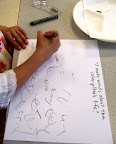How can we make time to teach science in preK-2 classrooms?
By Peggy Ashbrook
Posted on 2009-03-17
Observing the life cycle of an insect can include measuring growth and weight, counting calendar days and reading fiction, non-fiction, and writing poetry and descriptions—all ways to integrate science with other subjects in elementary school. Many skills and much information, such as, learning about the continents and names of land forms, how to read or make a map, learning what are natural resources, understanding weather vocabulary, how to describe parts of a whole, using pictures to check for meaning, using graphic organizers, re-telling a story or event using the beginning-middle-ending format, recognizing that letters are symbols for sounds, comparing story traditions of own and other cultures, asking and answering questions, using graphs, charts, and signs to acquire information, and using prior knowledge to predict meaning and make sense of texts are all skills that can be taught during science activities as well as during the reading, math, and social studies time periods.


Whew! Children learn so much in the early childhood school years and it all seems to connect.
What kinds of lesson plans do you teach which integrate science with social studies, math, and language arts?

Disclaimer: The views expressed in this blog post are those of the author(s) and do not necessarily reflect the official position of the National Science Teaching Association (NSTA).


